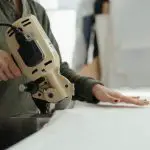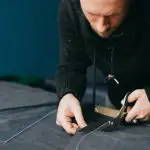You've probably heard the saying 'horses for courses' – well, it applies to scissors too.
Using fabric scissors for paper may seem like a convenient shortcut, but it can lead to a host of problems. The material differences between paper and fabric can cause blade damage and compromise the precision cutting required for detailed work.
Additionally, paper can dull the blades of fabric scissors, making them less effective for their intended purpose. Maintenance concerns also arise, as paper debris can get caught in the scissors, leading to fabric fraying and reducing their longevity.
Understanding the reasons behind why fabric scissors are not for paper will help you maintain the quality of your tools and achieve better results in your projects.
Key Takeaways
- Fabric scissors are designed with material durability in mind and have strong, resilient metals.
- Using fabric scissors on paper can dull the blades and compromise their effectiveness on fabric.
- Blade damage directly impacts the performance and lifespan of fabric scissors.
- Proper usage and maintenance of fabric scissors, including avoiding use on non-fabric materials, helps preserve their cutting efficacy and precision.
Material Differences
You should use fabric scissors for fabric because paper can dull the blades more quickly due to its abrasive nature. Fabric scissors are designed with material durability in mind, using strong, resilient metals that can withstand the cutting resistance of various fabrics. The blades of fabric scissors are often coated or made of materials that enhance their cutting resistance, ensuring longevity and precision when cutting through different types of fabric.
When paper is cut with fabric scissors, the abrasive nature of paper can cause the blades to wear down faster, reducing their cutting effectiveness on fabric. This is because paper fibers can cause microscopic nicks and damage to the blades, impacting their ability to cleanly cut through fabric. Therefore, to maintain the optimal cutting performance of fabric scissors, it's essential to reserve them exclusively for fabric and avoid using them on paper or other abrasive materials.
Understanding the material differences between fabric and paper is crucial in preserving the sharpness and durability of fabric scissors, ultimately ensuring precise and effortless fabric cutting for a longer period.
Blade Damage
The damage caused to fabric scissors when used on paper is often underestimated, resulting in a significant reduction in their cutting efficacy on fabric. When fabric scissors are used on paper, the blades can become dulled and nicked. This damage is more than just a cosmetic issue; it directly impacts the performance and lifespan of the scissors.
Proper blade care is essential to maintain the sharpness and effectiveness of fabric scissors. To prevent blade damage, it's crucial to use the scissors only for their intended purpose, which is cutting fabric. Avoid using them on paper, cardboard, or other non-fabric materials.
Additionally, storing the scissors properly, such as in a protective case or hanging them with the blades covered, can prevent accidental damage. Regular maintenance, such as cleaning and oiling the blades, is also important for preserving their sharpness.
Precision Cutting
To achieve precise cutting with fabric scissors, ensure that the blades aren't damaged from previous use on non-fabric materials. The sharpness of the blades is crucial for achieving clean and accurate cuts in fabric. Regularly sharpen your fabric scissors using a sharpening tool designed specifically for scissors to maintain their sharp edge.
Additionally, exercise edge control by using the entire length of the scissor blades to guide the fabric smoothly through the cutting process. This will help you maintain control over the fabric, resulting in precise cuts. Pay attention to the angle at which you hold the scissors in relation to the fabric to ensure that you're cutting along the desired line.
When cutting intricate patterns or curves, make small, strategic cuts to maintain precision. By practicing good maintenance and control techniques, you can ensure that your fabric scissors consistently deliver the precise cuts necessary for professional-level sewing and crafting projects.
Maintenance Concerns
Regular sharpening of fabric scissors is essential to maintain their cutting precision and edge control. However, maintenance concerns go beyond just sharpening. To keep your fabric scissors in optimal condition, it's crucial to address rust prevention and utilize proper cleaning methods.
Here are some key maintenance tips to ensure the longevity of your fabric scissors:
- Regular Sharpening: Sharpen the blades using a sharpening stone or professional sharpening service to maintain cutting precision.
- Rust Prevention: Keep the scissors dry to prevent rust formation, and consider using a rust inhibitor or storing them in a dry environment.
- Cleaning Methods: Wipe the blades with a soft cloth after each use to remove any fabric debris or residue, and periodically clean them with a mild solvent to prevent buildup.
- Proper Storage: Store the scissors in a protective case or sheath to prevent damage to the blades and to maintain their sharpness.
Fabric Fraying
When cutting fabric with scissors, fraying can occur along the edges, requiring proper techniques to minimize it.
To prevent fraying, it's crucial to use sharp fabric scissors and avoid using them for paper or other materials.
Additionally, you can consider using pinking shears, which have zigzag edges that can help reduce fraying.
Another effective method is to apply a thin layer of clear nail polish or fabric glue along the cut edges of the fabric to reinforce and seal the fibers. This simple technique can significantly enhance edge durability and prevent fraying.
Furthermore, using sergers or overlock machines to finish the raw edges of fabric can provide a professional and durable finish, preventing fraying and ensuring the longevity of the fabric.
Scissor Longevity
To maintain scissor longevity, regularly sharpening the blades is essential for optimal performance and cutting precision. Proper care and maintenance will ensure that your scissors remain effective for a longer period. Here are some key tips to help you prolong the life of your scissors:
- Regular Sharpening: Keep the blades sharp by using a professional sharpening service or a sharpening stone designed for scissors. Dull blades can damage the fabric and lead to fraying.
- Proper Storage: Store your scissors in a dry place to prevent rusting. Consider using blade guards to protect the sharp edges when not in use.
- Cleaning: Remove any debris or adhesive residue from the blades after each use. Use a soft cloth and a mild solvent to clean the blades, ensuring that they're completely dry before storing them.
- Appropriate Cutting Techniques: Avoid using fabric scissors to cut materials they aren't designed for, as this can cause unnecessary wear and tear. Additionally, use the entire length of the blades when cutting to distribute the pressure evenly and prevent premature dulling.
Frequently Asked Questions
Can I Use Fabric Scissors for Cutting Paper in an Emergency?
In an emergency, you can use fabric scissors for cutting paper, but be cautious. Paper can dull the blades and cause damage. It's best to reserve fabric scissors for fabric and have a separate pair for paper.
What Are the Best Ways to Prevent Fabric Scissors From Getting Dull?
To prevent dullness in fabric scissors, regularly sharpen them or have them professionally serviced. Use a dedicated pair for fabric only, and avoid cutting paper or other materials. Employ proper cutting techniques to maintain sharpness.
Are There Any Special Techniques for Cutting Delicate Fabrics With Scissors?
When cutting delicate fabrics with scissors, use precise techniques to avoid long-term damage. Maintain blade sharpness by sharpening regularly. In emergency paper cutting, use a separate pair of scissors to prevent dulling. Care for your blades diligently.
How Often Should I Sharpen My Fabric Scissors?
You should sharpen your fabric scissors every 6-12 months for optimal performance. Proper maintenance includes wiping the blades clean after use and storing them in a dry place. Avoid emergency use for paper, as it can damage the blade.
Can Using Fabric Scissors for Paper Cause Any Long-Term Damage to the Blades?
Using fabric scissors for paper can damage the blades long-term. It affects blade maintenance and scissor longevity. Paper dulls the blades faster than fabric, reducing cutting effectiveness. Stick to using fabric scissors for fabric and paper scissors for paper.
- How Does Ring Spun Cotton Affect Garment Fit and Shape Retention? - August 13, 2024
- What Are the Challenges in Producing Ring Spun Cotton? - August 13, 2024
- Is Ring Spun Cotton Suitable for Plus-Size Clothing? - August 13, 2024







